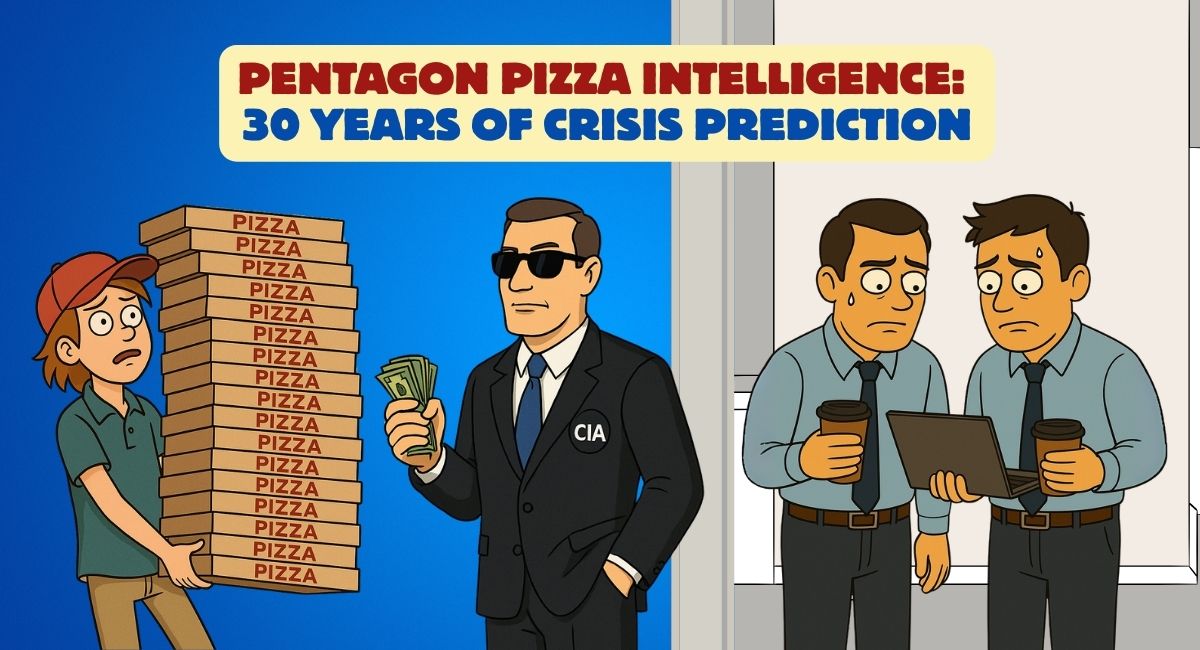Pentagon Pizza Intelligence: What 30 Years of Crisis Prediction Teaches Us About Media Monitoring

Introduction: When Pizza Predicts War
In August 1990, the CIA famously ordered 21 pizzas in a single night. Hours later, Iraq invaded Kuwait.
Coincidence? Maybe. But to outside observers, that sudden late-night surge of food deliveries to Langley looked like an early-warning signal. Something was happening — and the pizza boxes gave it away.
This quirky phenomenon became known as the Pentagon Pizza Index (sometimes the Pizza Meter, sometimes just “PizzINT”). For decades, journalists, intelligence analysts, and even hobbyists have speculated that tracking pizza orders near the Pentagon and other U.S. government buildings could serve as a crude predictor of global crises.
Absurd? Absolutely. But it also illustrates a deeper truth: tiny, unrelated signals can foreshadow massive events. And that’s exactly what modern media monitoring does for brands.
From Cold War Pizzas to OSINT Myths
The Pizza Index isn’t a TikTok-era invention. Its roots stretch back to the Cold War, when Soviet operatives allegedly monitored food deliveries around U.S. government buildings.
Why? Because high-stakes decisions don’t keep office hours. When officials were forced to work overnight, they needed fuel — and pizza became the go-to. More late-night boxes at the Pentagon meant something serious was brewing.
The idea resurfaced during the 1991 Gulf War build-up. Reporters joked about spikes in Domino’s deliveries to Arlington. The CIA’s 21-pizza order before Iraq’s invasion of Kuwait became lore.
And the Pizza Index isn’t alone. Economists and cultural observers have long relied on “folk indicators” to read the room:
- The Big Mac Index (used to measure global purchasing power parity).
- The Hemline Index (skirt lengths supposedly rising and falling with economic optimism).
- The Lipstick Index (lipstick sales climbing during recessions as a cheaper luxury).
These may sound silly, but they reveal a timeless truth: humans are constantly searching for proxies. If you can’t measure the thing directly, find a signal hiding in plain sight.
Enter the Digital Age: pizzint.watch and the Pentagon Pizza Tracker
Fast forward to today.
Projects like pizzint.watch and social accounts such as Pentagon Pizza Watch and Pentagon Pizza Report have brought the Pizza Index into the digital era. Instead of anecdotal Domino’s sightings, they pull:
- Google Maps “popular times” data from pizzerias near the Pentagon.
- Food delivery app trends from services like Uber Eats.
- Geospatial visualization tools to track foot traffic patterns.
When spikes occur, they post alerts: “Pizza traffic near the Pentagon is off the charts tonight.”
It’s a fascinating experiment in OSINT (open-source intelligence). And in a few cases, spikes have lined up suspiciously close to breaking news — from Middle East escalations to cyber incidents.
But here’s the problem: just like the Cold War anecdotes, the Pizza Tracker suffers from false positives, data gaps, and correlation vs. causation. A Friday-night surge might just mean a Nationals game ended early. Google Maps foot traffic data can lag or misfire. And Pentagon security protocols make mass pizza deliveries unlikely in the first place.
So while it’s fun to watch, even the Washington Post has warned: the Pentagon Pizza Index is a meme, not a method.
The PR Lesson: Brands Leave “Pizza Orders” Too
And yet… the metaphor is too good to ignore.
Because just like governments leave odd little signals, so do brands. We call them early-warning signs.
For governments, it’s pizza boxes. For companies, it might be:
- A sudden Reddit thread complaining about product safety.
- A local news report questioning environmental practices.
- A spike in Google searches like “Is [Brand] shutting down?”
- TikTok chatter picking up on pricing or packaging long before mainstream coverage.
These are the “pizza orders” of brand reputation. Tiny, often-overlooked anomalies that, if spotted early, can give communicators the head start they need.
Ignore them, and you’re stuck in full-blown crisis mode at 2 a.m. Respond to them, and you can control the narrative before it snowballs.
From Pizza OSINT to Professional Monitoring
The Pentagon Pizza Index proves a point, but it also proves its own limits. What brands need is not more pizza myths, but real monitoring intelligence.
That’s where Fullintel comes in.
We combine:
- AI-powered platforms that filter billions of data points in real time.
- Expert media analysts who contextualize signals and eliminate noise.
- Reputation-focused metrics like the Media Impact Score and Trust Score that actually show risk and opportunity.
In other words: Pentagon pizza spikes make great headlines. But what if instead of speculative proxies, you had validated, continuous intelligence from traditional media, social platforms, niche outlets, and policy sources?
That’s what Fullintel provides. It’s pizza intelligence — without the guesswork.
Case Studies: When Early Signals Mattered
To bring this home, let’s step out of the pizza shop and into the brand world.
- Healthcare: A niche subreddit begins spreading misinformation about a new therapy. It hasn’t hit mainstream media yet, but by monitoring those early voices, the brand can deploy facts and reassure stakeholders before CNN picks it up.
- Retail: A TikTok micro-trend ridiculing packaging starts among teens. Within a week, it’s covered by lifestyle blogs. Within a month, it’s on Good Morning America. Monitoring could have caught it at the TikTok stage.
- Financial Services: Local news in a single region flags an executive’s comments on interest rates. That one clip, unnoticed by national outlets, snowballs into a reputation story once Twitter amplifies it.
Each of these is a “pizza box” moment. Small. Local. Easy to miss. But once multiplied, they change the game.
Why PR Needs Its Own Pizza Index
The Pentagon Pizza Index may live in the gray space between myth and meme, but it highlights a critical principle: early signals matter.
The difference? Brands don’t have to rely on pizza trackers. You have the tools, analysts, and data to turn weak signals into strong intelligence.
At Fullintel, that’s our bread and butter (or sauce and cheese, if you prefer). We provide the dashboards, daily briefs, and reputation metrics that give organizations a real early-warning system — one that works whether the “crisis” is a hostile headline, a viral TikTok, or a brewing policy debate.
Conclusion: If Pizza Can Predict Geopolitics…
The Pentagon Pizza Index is equal parts fascinating, funny, and flawed. But its longevity proves something important: humans love finding patterns in the noise.
For brands, the lesson is clear. Don’t laugh off the small signals. Learn from them. Track them. Understand them.
Because if pizza can (sometimes) predict geopolitics, imagine what real media data can do for your brand.
Now — who wants to throw off Russia and order 100 pizzas with me? 🍕
Angus Nguyen
Angus Nguyen is the Director of Marketing at Fullintel and a proud member of the “I read the AI Overviews so you don’t have to” club. He spends his days obsessing over media measurement, digital trends, and why your best-performing PR story might be invisible to AI. With 7+ years of experience in brand strategy and media intelligence, Angus helps comms teams future-proof their visibility in an AI-first world. When he’s not decoding Google’s latest algorithm update, he’s probably hunting down the best bánh mì in Toronto—or creating viral content about it.
📌 Follow Angus for fresh takes on AI media monitoring, PR analytics, and the future of brand visibility.
Angus Nguyen, Director of Marketing at Fullintel, specializes in data-driven public relations and media monitoring. His experience analyzing media trends and their global impact provides insights into PR challenges in the automotive sector amid geopolitical developments. Angus excels at separating signal from noise, helping brands focus on actionable insights for stakeholder communication and crisis management.

